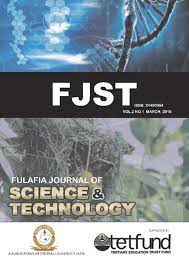Cytological Studies of Tomato (Solanum Lycopersicum L.) Cultivars grown in Lafia, Nasarawa State-Nigeria
DOI:
https://doi.org/10.62050/fjst2024.v8n2.317الكلمات المفتاحية:
Cultivars, Cytological, Grown, Studies, Tomatoالملخص
Abstract
The study was carried out to investigate the cytological relatedness of five different tomato cultivars. Ten (10) seeds from each tomato lines were grown at room temperature in Petri dishes. The germinated Root tips were collected and treated using 0.04 8-hydroxyl quinolone for 2 h. Then, the root tips were fixed using 3:1 (v/v) ratio of alcohol: glacial acetic acid for 24 h. The root tips were hydrolyzed in 1.0 N HCl for 20 min at room temperature. These root tips were placed on slides, stained using 2% aceto-orcein stain and then mounted on Olympus CX40 microscope at X100mg. Photomicrographs were taken. Karyotype analyses were carried out using Karyotype software, and the ideograms were drawn. Different karyotype parameters were measured and mentioned. The result revealed that the chromosomes number of all the genotypes were the same (2n=24) except for cirea with 2n=26 number of chromosomes. The highest total form index (TF %), symmetric index (Syi) and the lowest karyotype asymmetric index (ASK), Mona f1 is the most symmetric while boomerang f1 is the most asymmetric. Further studies can be carryout on cirea cultivar to ascertain the variability caused of 2n = 26. It’s also recommended that hybridization should be carryout between cirea cultivar and other cultivars having 2n =24 for future genetic improvement.
التنزيلات
المراجع
References
Badr, A., Khalifa, S. F., Aboel-Atta, A.I., Abou-El-Enain, M. M. (1997). Chromosomal Criteria and Taxonomic Relationships in the Solanaceae. Cytologia, 62, 103–113. DOI: https:doi.org/10.1508/cytologia.62.103
Fonsêca, A. and Pedrosa-Harand, A. (2013). Karyotype stability in the genus Phaseolus evidenced by the comparative mapping of the wild species Phaseolus microcarpus. Genome, (56): 335–343. DOI: https:doi.org/10.1139/gen-2013-0025
Moscone, E., Scaldaferro, M., Grabiele, M., Cecchini, N., García, Y.S., Jarret, R., Daviña, J., Ducasse, D., Barboza, G., Ehrendorfer, F. The evolution of chili peppers (Capsicum-Solanaceae): A cytogenetic perspective. Acta Hortic. 2007, 745, 137–170. DOI: https:doi.org/10.15446/acag.v66n4.59162
Murat, F., Zhang, R., Guizard, S., Gavranovic, H., Flores, R., Steinbach, D., Quesneville, H., Tannier, E., Salse, J. Karyotype and gene order evolution from reconstructed extinct ancestors highlight contrasts in genome plasticity of modern rosid crops. Genome Biol. Evol. 2015, 7, 735–749. DOI: https:doi.org/10.1093/gbe/evv014
Peralta I. E., Spooner, D. M., Knapp , S., (2008). Taxonomy of wild tomatoes and their relatives. (solanum sect. juglandifolia,sect. lycopersicon; solanaceae). January 2008. Systematic botany monograph 84:1-186. DOI: 10.2307/25027972
Zuo, L and Yuan, Q. (2011).The difference between the heterogeneity of the centromeric ssindex and intrachromosomal asymmetry. Plant Syst. Evol. 2011, 297, 141–148.
DOI:10.1007/s00606.011-0528









